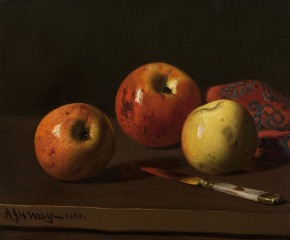
Andrew John Henry Way (1826–1888)
Still Life of Apples, 1883
Oil on canvas, 9 7/8 x 13 7/8 in.
Signed and dated lower left AJH Way – 1883.
Provenance: Adams Davidson Galleries, Washington, D.C.; private collection, Charleston, South Carolina, until 2024
Exhibited: Gibbes Museum of Art, Charleston, South Carolina, December 2, 2016–April 23, 2017 (and traveling), Painting a Nation: Hudson River School Landscapes from the Higdon Collection, illustrated in exh. cat., 42, pl. 21.
Way is best known for his still lifes of the oysters that abounded in the Chesapeake Bay, which were so successful that they made critics’ mouths water,[1] and for his scientifically accurate clusters of grapes. But he did not limit himself to these subjects, as his output also consists of more elaborate tabletop still lifes of fruits such as cherries, peaches, and melons. Apples make frequent appearances, either combined with other fruits, or as here, singled out for close inspection. In Still Life of Apples, three rather large, bruised, and mottled fruits are placed directly on a plain wooden kitchen table. A pearl and silver handled knife points into the composition, the reflection of the apple to its right reflected in its polished blade. A richly colored, embroidered cloth sits crumpled on the corner of the table, adding depth and texture to the composition.
[1] Susan Danly and Bruce Weber, For Beauty and for Truth: The William and Abigail Gerdts Collection of American Still Life (Amherst, Mass.: Mead Art Museum, Amherst College; New York: Berry-Hill Galleries, 1998), 90.